The following section covers the newly introduced segmented ledger account entry in Microsoft Dynamics AX 2012 and the financial dimensions' assignment in a one-line voucher entry.
Microsoft Dynamics AX 2012 introduced the segmented ledger account where the main account and the financial dimension are combined in a single line. This gives more flexibility and control to the data that is entered than the previous versions.
The data entries are considered as the major sources of information quality. During the analysis phase, the implementation team exploring the reporting requirements as well as the process owners and top management require reliable information, and this information is generated by the data entry. It is required to control the data entry to ensure that the entered data is formatted in the correct way. The application consultant can fulfill these requirements to ensure the quality of data entry by performing the following tasks: by defaulting some values from the master data that are automatically populated in the transaction, by changing fields to be mandatory for reporting, and by identifying the required financial dimensions to the transaction level.
Microsoft Dynamics AX 2012 offers a very powerful entry mechanism that is built on the account structure. The segmented entry control is a function that simplifies the data entry and controls the complex combination of accounts and financial dimensions.
It is a simple cheat sheet window that gives the user hints on which segment should be entered, in addition to the lookup for that segment.
To access the general journal, navigate to General ledger | Journal | General journal lines. The following screenshot shows the simple cheat sheet in detail:

In this section, we will explore the further enhancement of segmented entries that gives more flexibility to Microsoft AX 2012 to accommodate the one-line entry to allocate the segments. This was followed in previous versions of Microsoft Dynamics AX, where the default application assigned dimensions to both the sides (debit and credit), enforcing the end users to use the double-line entries to have different financial dimensions for each side.
Microsoft AX 2012 covers this point completely. If an entry is created in a one-line style, the voucher created is that of a debit (vendor) or credit (bank) and requires the assigning of different segments. Here is a new feature where we will be able to assign different financial dimensions for Account and Offset account. Navigate to General ledger | Journals | General Journal, and then go to Lines. In the general journal form, click on the Financial Dimension button. There are two options here, Account and Offset account, as shown in the following screenshot:

There was an obstacle facing the implementation team in assigning master data to financial dimensions such as vendors, customers, fixed assets, items, and banks, and the best-case scenario to tackle this is an automatic (online) assignment in order to keep consistency of assigning the default financial dimension to the master data. The solution for this requirement is that it will either be maintained manually or by an automatic trigger (customization). Microsoft Dynamics AX 2012 has bridged this gap. Microsoft Dynamics AX 2012 has two types of financial dimensions, as shown in the following diagram:

The first type is the user-defined dimension, which was used in Microsoft Dynamics AX 2009 to allow users to add an unlimited number of dimensions (business unit, cost center, purpose, profit center, and so on) as per the outcome of the analysis. The second type is the system-defined dimension. It helps in assigning the master data to newly created dimensions such as vendors, customers, fixed assets, and items.
The steps to create a new dimension are as follows:
- Navigate to General ledger | Setup | Financial dimensions as shown in the following screenshot:

- Within Financial dimensions, navigate to Financial dimensions, as shown in the following screenshot:

- Create a new financial dimension by clicking on New in the Financial dimensions window, as shown in the following screenshot:

- Select the dimension type.
- If you want to add a user-defined dimension, select <Custom dimension>, as shown in this screenshot:
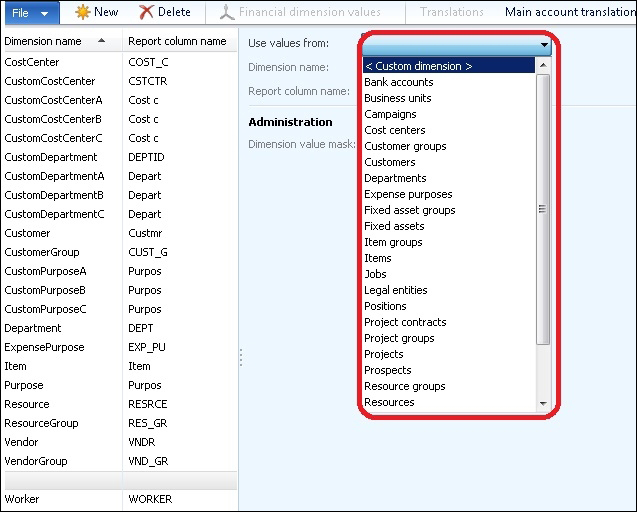
- Enter the user-defined dimension list and configure the dimension value by its dates of activation and/or suspension by filling in the Active from, Active to, and Suspended fields, as shown in the following screenshot:
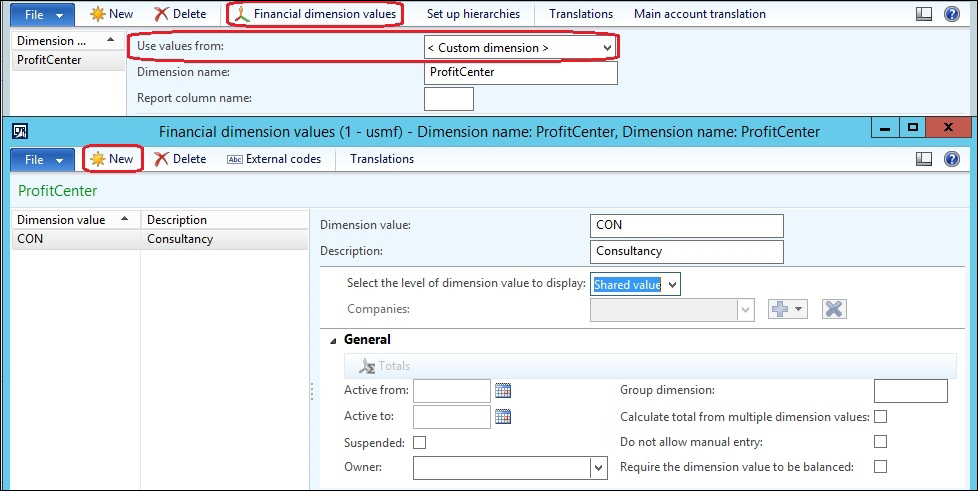
- Select the subledger values, for example,
Customers. Then select the financial values called from the customer's master data and configure the dimension value by its dates of activation and/or suspension. The Financial statement formatting and Cost accounting fields only show when the level of dimension display is selected at company level instead of shared level.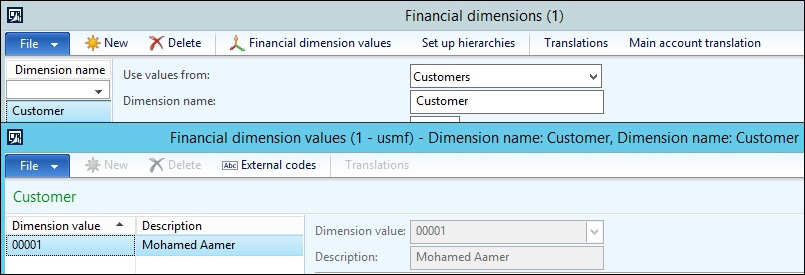
The account structure's configuration identifies the required dimensions for the main account. The account structure is attached to the company's ledger setup (refer to Chapter 1, Getting Started with Microsoft Dynamics AX 2012). As you can see in the following diagram, an account structure is a combination of the main account and financial dimensions:
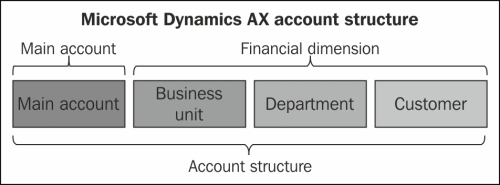
Microsoft Dynamics AX 2012 provides flexibility to add the account structure for the main accounts with any combination of financial dimensions.
Navigate to General ledger | Setup | Chart of accounts | Configure account structures to configure the account structures. As you can see in the following screenshot, Configure account structures should be in the edit mode to be edited:

Add a segment (financial dimension) to the account structure that is already defined (regardless of whether it has user-defined or system-defined dimensions) by clicking on the Add segment option, as shown in the following screenshot:
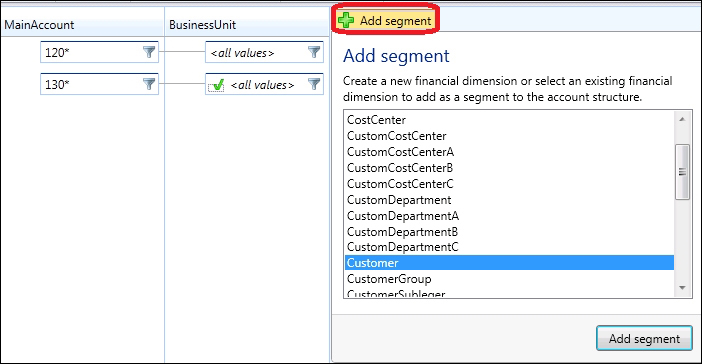
Microsoft Dynamics AX 2012 provides an option to identify the main account by identifying one specific account and/or a part of the main accounts. This is done by selecting Specify which values are allowed, as shown in the following screenshot. This provides the availability to use the filtration option.
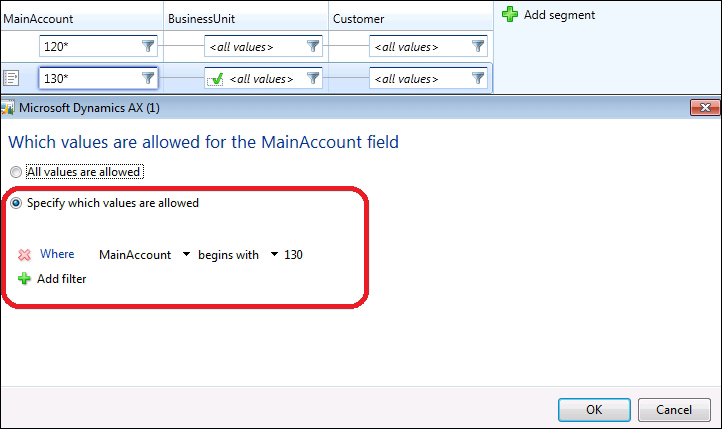
As you can see in the following screenshot, it is possible to arrange the order of the dimensions by moving the segments to the left or right, or by right-clicking to move the segment:

Accepting a blank (null) value in the dimension is possible. The feature of accepting a value or keeping it blank is introduced in Microsoft Dynamics AX 2012, and it is allowed for users to leave the dimension blank, as shown in the following screenshot:
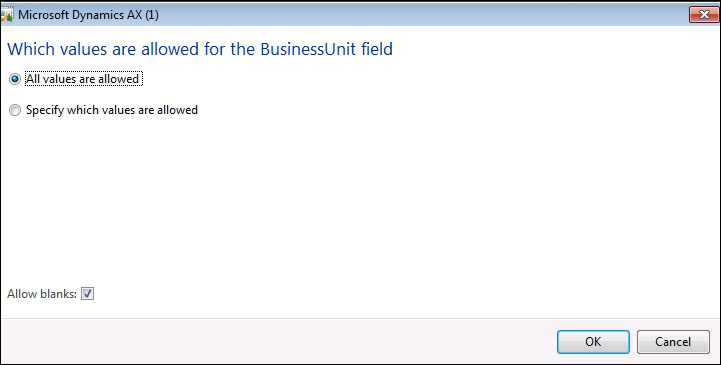
To apply the account structure configuration, it must be activated as shown in the following screenshot:

